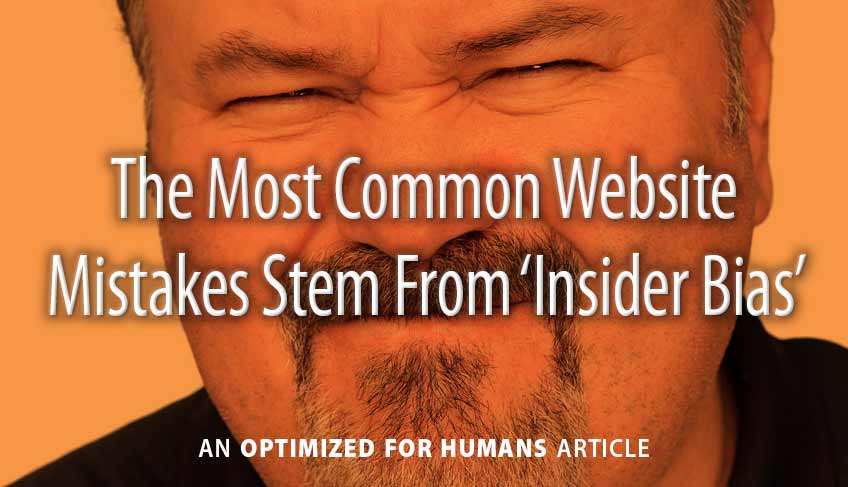
It’s a fact: You look at your own website differently than sites you visit when you’re the customer.
It’s a lesson that I’ve learned time and time again working with business owners. By and large, they’ve been smart people who have achieved some business success. But when it comes to their own website, they often have surprising blind spots.
I’ve had clients who insisted on certain approaches for their own site. But I knew that in the real world, if they saw those same approaches on somebody’s else’s site, their eyes would glaze over as they reached for the Back button.
I originally thought of this phenomenon as an aberration. But I’ve now come to see it as quite natural. Problematic, yes, but understandable.
We’re all too close to our own businesses to see them as others do.
That can result in a distorted view of what’s important.
When entrepreneurs think about what to put in their new website, they may start at the beginning, with a focus on company’s history and their own professional experience.
They look around, and what they see are their employees. Or their firm’s physical facilities.
So, left to their own devices, they might fill their web home page with things like, “Over twelve years of industry experience.” Or “Two companies merged to serve you better.” Or “Our difference is our people.” Or “Everything is assembled in our new 20,000 sf plant.”
That’s when their web visitors reach for their own Back button.
Crash. Burn. And the company owner wonders why they’re not getting nearly the engagement, leads or conversions their web designer originally promised.
I try to empathize, really, I do. It’s not easy separating oneself from one’s own point-of-view. I know, because I too struggle with that same bias when it comes to my own stuff.
But in a highly competitive online marketing universe, not taking one’s thinking to the next level can result in being left behind.
Why? Because while a company website may have come from company insiders, it’s not for company insiders.
It turns out that their visitors and potential customers have a completely different set of eyes, needs, issues, circumstances, sensibilities and perspectives.
When I’m the customer, a company’s self-centered, self-serving attempt to impress me by yakety-yakking about themselves has the exact opposite effect.
As that first-time visitor, I have an issue to resolve, or an aspiration to achieve. A company that clearly understands, and stays tightly focused on, what’s important to me is far more likely to grab and keep my attention.
It takes smart web writing to translate the positives from the company’s perspective to the buyer’s perspective.
Have you ever heard the phrase, “It’s about benefits, not features”?
I don’t care that your carpet cleaning service uses proprietary-formulated solvents to neutralize residual emulsifiers. But I do care that there’s no sticky, soapy residue left on my carpet. Actually, you’d be on target if you led with the second one, then backed up your claim with the first one.
That’s often a problem with company insiders writing own web copy – they know their company, products and processes; in fact, they’re so close to it that their words tend to appeal to other company insiders with something to sell, rather than real-world buyers with a problem to solve.
On their sites, company employees also tend to copy the same worn out phrases as their competitors, which makes them feel safe, but of course, that’s no way to stand out in a competitive marketplace.
No one recognizes their own insider bias. The other insiders around us don’t notice it because they share the exact same same unobjective view.
When reviewing their new website design, insider bias causes company staff to read every single word, because they have inherent interest in their own company. They may not notice that the text is too small, or too boring, to be readily read by real-world visitors who are more likely scanning the web page to see if anything jumps out and catches their eye.
On the other hand, a thoughtful discovery process with an outside consultant or writer can help company insiders stand back, for a wider view of what they bring to people’s lives. And also look closer to get a genuine understanding of the customer’s predicament, underlying needs, and hopeful aspirations – as well as their feelings about these things.
Taking that kind of deep-dive approach helps companies actually aim before pulling the marketing trigger. Which in turn gives them a chance to make a more memorable, meaningful connection with folks than competitors who go on and on about what they think of themselves.
Wondering why your own website isn’t getting the responses you’d like? Hmm. Maybe we need to take a closer look.
Ask about a custom Website Review and Recommendations Report. What might you learn?
Get specific ideas, insights and info to enhance engagement and conversions on your website. Get In Touch
Share It:
 About the Author: Tom Tortorici is an Atlanta copywriter and web content writer who helps companies make a genuine connection with their audience. His classes and conference presentations have focused on how writing, strategy and design can work together to grab attention and interest even among readers with short attention spans. In addition to working directly with businesses, Tom regularly partners with web designers and marketing agencies.
About the Author: Tom Tortorici is an Atlanta copywriter and web content writer who helps companies make a genuine connection with their audience. His classes and conference presentations have focused on how writing, strategy and design can work together to grab attention and interest even among readers with short attention spans. In addition to working directly with businesses, Tom regularly partners with web designers and marketing agencies.
All Posts/Subscribe >
Info for Businesses >
Info for Designers/Agencies >
Tom Tortorici Inc. | Tom@TomTortorici.com | 770-934-7861 | 3101 Rockaway Rd | Atlanta GA 30341
